No CrossRef data available.
Article contents
Teaching the Art of Judgment
Published online by Cambridge University Press: 07 March 2023
Abstract
An abstract is not available for this content so a preview has been provided. Please use the Get access link above for information on how to access this content.

Information
- Type
- Theories and Methodologies
- Information
- Copyright
- Copyright © 2023 The Author(s). Published by Cambridge University Press on behalf of the Modern Language Association of America
References
Works Cited
Arendt, Hannah. “Introduction into Politics.” The Promise of Politics, edited by Kohn, Jerome, Schocken Books, 2005, pp. 93–200.Google Scholar
Arendt, Hannah. Lectures on Kant's Political Philosophy. U of Chicago P, 1982.CrossRefGoogle Scholar
Arendt, Hannah. “Some Questions of Moral Philosophy.” Responsibility and Judgment, edited by Kohn, Jerome, Schocken Books, 2003, pp. 49–146.Google Scholar
Kant, Immanuel. Critique of Judgment. Translated by by Pluhar, Werner S., Hackett, 1987.Google Scholar
Klinger, Florian. “To Make That Judgment: The Pragmatism of Gerhard Richter.” Judgment and Action: Fragments toward a History, edited by Soni, Vivasvan and Pfau, Thomas, Northwestern UP, 2018, pp. 239–68.Google Scholar
Wollaeger, Mark. “Taste, Value, and Literary Aesthetics.” American Comparative Literature Association conference, 2021.Google Scholar

